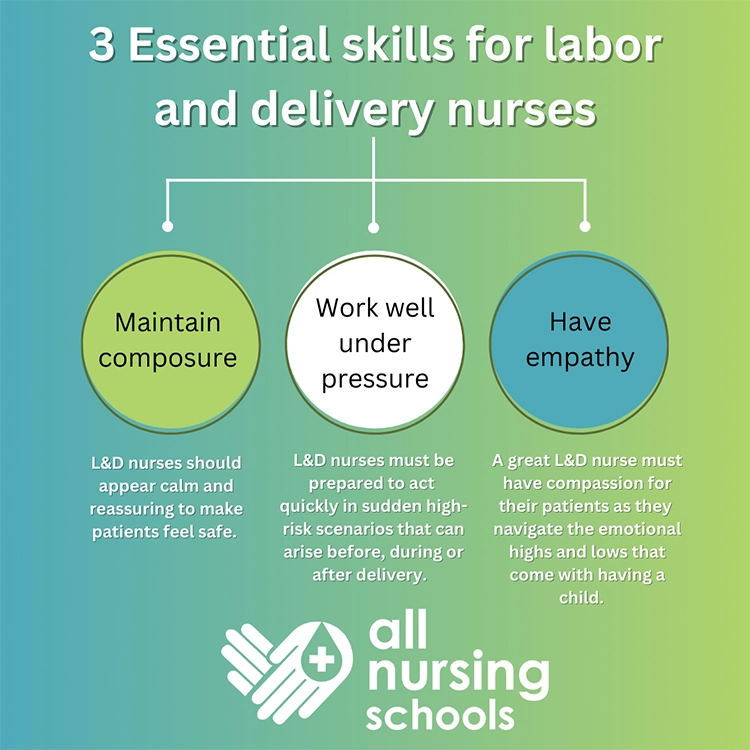Explore Related Nursing Specialties
Becoming an L&D Nurse: Education, Duties and Salary

Labor and Delivery Nurse Overview
Where you’ll work: Labor and delivery units and birthing centers in hospitals.
What you’ll do: Specialize in the care of pregnant women from the time they are admitted for delivery through the birthing process.
Minimum degree required: A BSN is typically the minimum degree for a labor & delivery nurse, though some places may only require an ADN.
Who it’s a good fit for: Labor & delivery nurses are often who the patient looks to for reassurance and comfort whether or not complications arise. These nurses therefore should be calm, compassionate and have strong communication skills. They must be able to adapt quickly to changing situations if complications do occur.
Job perks: Being a labor & delivery nurse can be a jumping-off point to other similar nursing specialties, such as becoming a nurse-midwife or a neonatal nurse.
Opportunities if you pursue a higher degree or certification: Although it is not required, nurses who pursue a specialty certification such as Inpatient Obstetric Nursing Certification (RNC-OB) may have an edge in future career opportunities. This could also make it easier to transition to other specialties by demonstrating your expertise.
Median annual salary: $86,070
The job of a labor and delivery nurse is arguably one of the most gratifying—and potentially harrowing—of all nursing careers. When a birthing outcome is happy, the nurse will relish his or her supporting role. On the other hand, when the result is traumatic, the nurse’s resolute calm, knowledge, and strength are vital.
In this Article
Whether it’s the happiest or hardest moment of a parent’s life, the labor and delivery nurse plays a significant role in this experience and can be an incredibly rewarding nursing specialty to pursue.
What Does a Labor and Delivery Nurse Do?
This important healthcare provider is the person who spends the most time with a woman in labor during childbirth—even more than the doctor who will ultimately deliver the baby. For relatively quick births, the nurse in this role may be at the woman’s side from the time she arrives at the hospital until shortly after the baby is delivered. For longer births (or those with complications or added procedures like a C-section) that span more than one shift, multiple nurses may share in the care. For this reason, sometimes L&D nurses don’t experience a woman’s birth journey to the end.
“When you are a labor and delivery nurse, you’re the one who has to know what’s going on with the mother and child at all times,” says Mary Terranova, CNM, MSN BSN, a certified nurse midwife who spent more than 12 years as a labor and delivery nurse. “Especially at night. You’re the only one around.”
A labor and delivery nurse watches over the fetal heartbeat monitor and the mother’s health in what can be a long haul before the actual delivery. They’ll call a doctor only if there’s a sign of trouble or when the baby’s birth is imminent. And even when it seems to be moving along slowly, the L&D nurse knows that there’s a lot they have to track—and it can all turn critical at any moment.
The most important skill labor and delivery nurses can have in addition to their medical knowledge is the ability to appear calm and reassuring.
“Labor and delivery nurses have to be able to handle an emergency and the adrenaline rush,” Terranova says. “It can all be quiet and then, in a second, everyone is rushing to save lives.”
Registered Nurse Kathleen “Kitty” Law, of Port Charlotte, Florida, nursed pregnant women through a good part of her 46-year career. She says the most important skill that labor and delivery nurses can have in addition to their medical knowledge is the ability to appear calm and reassuring even when the outcome may not be a live birth.
“Every delivery really is considered high risk,” she says. “You never know what may happen and you have to be ready for anything.”
This specialty is also a jumping-off point for several other specialty careers. Terranova has been a practicing midwife for 22 years, and Law spent 15 years caring for mothers in a high-risk birth unit, a very different specialty.
Others may become neonatal nurses, looking to take care of babies after they’re born or focus on prenatal and fertility nursing to help ensure there is a healthy birth from the start.

Labor and Delivery Nurse Schooling Requirements
Students interested in labor and delivery nursing should think about their future while planning their education. Typically, a Bachelor of Science in Nursing (BSN), rather than a two-year associate degree, is required at most hospitals, says Joan Edwards, PhD, RNC, CNS, FAAN, a labor and delivery nurse and former president of the Association of Women’s Health, Obstetric and Neonatal Nurses (AWHONN).
Most of the actual training takes place on the job, says Brandy Colletti, MSN-ED, MBA/HCM, PHN, RN, a labor and delivery nurse for 23 years and an assistant professor at West Coast University. If you’re interested in this field, she recommends that you take at least one class while in school that is related to maternity and newborns and includes clinical hours.
Are Any Certifications Required?
Certification is not required to become a labor and delivery nurse, but earning a specialty certificate can give you an edge.
“Once a new grad passes NCLEX, they can start a labor and delivery position without any previous specialty education,” says Edwards. “Most facilities do offer internships over a number of months, which is basically classroom content with a preceptor (trainer) so that by the time they finish their internship, they are safe practitioners in this specialty area of practice.”
Internships, which are essentially on-the-job training given after you are hired, can take from six weeks up to one year. Topics covered often include stages of labor, Cesarean births, anesthesia, and non-pharmacologic pain relief.
After graduation, some nurses will often take additional courses in fetal heartbeat monitoring to better position themselves for a job, Edwards says. In addition, any facility with acute care areas requires that all nurses have basic life support (BLS) training.
Some facilities will look for nurses who already have Inpatient Obstetric Nursing Certification (RNC-OB) through the National Certification Corporation or will require it after two years. Edwards says it’s a very desirable certification. Candidates must be RNs with at least 2,000 hours of education, research, or labor and delivery experience, and they must have been employed in the specialty within the last two years. The cost to take the lengthy test is $325.
How Much Time Will My L&D Nursing Education Take?
For most labor and delivery nurses, it takes four years to complete a BSN. Many nurses go on to get master’s or doctoral degrees, which could add another two to four years.
Continuing Education Requirements for L&D Nurses
In addition to their education, nurses are required to take continuing education courses in most states to renew their licenses.
According to Edwards, who is also a professor at Texas Woman’s University in Houston and director of its Center for Global Nursing, continuing education units, as they are known in nursing, will build on their experience.
“Most states only require a certain number—usually about 20 CEUs—every time state licensure to practice is renewed: every two years in most states, she says. “Some states require some of those hours to be in the area of specialty practice. Some don’t.”
What Kind of Licensing Do I Need?
Most hospitals require that labor and delivery nurses be registered nurses. Once you have earned a BSN, you must sit for the NCLEX-RN exam, the national exam you must pass to practice as a registered nurse in the United States. The fee for that exam is typically $200.
States will also charge an initial licensing fee anywhere between $40 to $375, which is renewed periodically—typically every two years. It’s important to check specific regulations in your state, however.
Labor and Delivery Nurse Career Outlook
Even with more mothers now looking to experience home and more natural births according to Birth, a medical journal dedicated to perinatal care, the field continues to grow. Overall, the U.S. Bureau of Labor and Statistics predicts that the registered nursing field will grow faster than average for all occupations—5.6%—through 2031.
In fact, although birth rates have dropped slightly in recent years as reported by the National Center for Health Statistics, with an increase in the average age of mothers giving birth and more opportunities for fertility options, the demand for labor and delivery nurses continues to grow.
Eight Ways To Stand Out as a Labor and Delivery Nurse Job Candidate
L&D nursing is rewarding and many graduates are interested in those jobs, and hospitals are often looking for the top candidates, says Edwards, who believes the employment outlook in this field is still good despite a higher level of competition in what is perceived as a “happy” nursing field.
“Just like any other area of nursing, some nurses are always getting close to retirement,” she says. “Nurses are being hired with no experience in labor and delivery usually about two times a year at the end of spring and fall semesters when new graduates emerge from nursing programs. Departments also hire throughout the year, depending on retirements and vacancies for other reasons.”
But it’s still competitive for those one or two spots that open up a year. Check out Edwards’ tips for making your application stand out. Adding any or all to your resume will give you an advantage:
Labor and Delivery Nurse Salary
According to the U.S. Bureau of Labor and Statistics (BLS), registered nurses’ 2021 median annual pay was $86,070 a year (and average earnings could be as much as $85,020 if they specifically work in a hospital). Nurses with educations beyond their bachelor’s degree can earn more. And, according to nursing faculty and employers, labor and delivery nurses can also earn more when they become instructors in related fields, such as lactation consulting, prenatal care and home care support. Take a look at median annual RN salaries by state:
In nursing, as in education and similar fields, your pay is often directly impacted by your level of schooling, according to the BLS. In addition, medical research is always revealing new standards of medical care, so, for some, continuing their education can become a passion.
Stay Informed in the Field
Once you’ve decided you’d like to pursue Labor and Delivery Nursing as a specialty, you’ll want to stay informed. Joining an association is a great way to stay on top of hiring opportunities, continuing education classes, trends, and new research.
Association of Women’s Health, Obstetric, and Neonatal Nurses
AWHONN is a nonprofit organization whose mission is to improve and promote the health of women and newborns.
National Association of Neonatal Nurses
NANN is dedicated to neonatal nursing careers, though some complementary continuing education opportunities may also interest labor and delivery nurses.
Is Labor and Delivery Nursing the Right Specialty for You?
Both Colletti and Edwards say that having the ability to think critically in an emergency and withstand the adrenaline rush of a new birth are essential skills for Labor and Delivery Nurses. For that reason, spending time in an ICU or emergency room can help you determine whether it’s a good fit for you.

With professional insight from:

Certified Nurse Midwife

Registered Nurse

Joan Edwards, PhD, RNC, CNS, FAAN
Labor and Delivery Nurse; Director, TWU Center for Global Nursing; and Former President, Association of Women’s Health, Obstetric and Neonatal Nurses (AWHONN)

Brandy Colletti, MSN-ED, MBA/HCM, PHN, RN
Labor and Delivery Nurse, Assistant Professor at West Coast University
